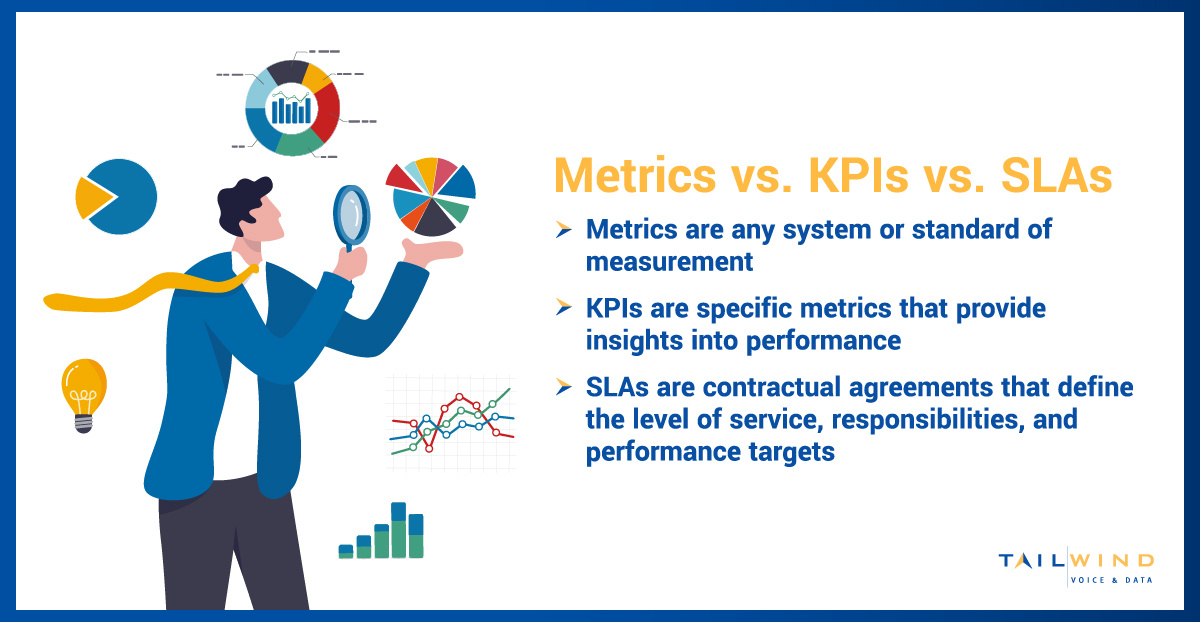Network operations centers (NOCs) play a critical role in ensuring the reliability, security, and performance of an organization's IT infrastructure. However, managing a NOC requires teams to juggle multiple responsibilities, from proactive monitoring and incident response to performance optimization and compliance with service level agreements (SLAs).
Amidst this complexity, the lack of actionable performance metrics can leave NOC teams feeling overwhelmed and unable to accurately assess their workload. Investing in tracking the right NOC KPIs and performance metrics is essential for breaking this cycle and empowering teams with the insights they need to enhance service delivery, meet SLA targets, and ensure business continuity.
In this blog, we'll explore the critical metrics and KPIs that NOCs should monitor to achieve optimal performance.
Network Operations Center Metrics, KPIs, and SLAs Defined
Before we dive into the specific metrics and KPIs, let's clarify the differences between some often-confused terms:
- Metrics: A metric is any system or standard of measurement. NOCs can measure hundreds of metrics, ranging from critical performance indicators to less significant data points.
- Key Performance Indicators: KPIs are specific metrics that provide valuable insights into the NOC's performance. These metrics are directly tied to the quality of service delivered to end-users or customers.
- Service-Level Agreements (SLAs): SLAs are contractual agreements that define the expected level of service, responsibilities, and performance targets. They also specify the metrics and KPIs that the NOC must meet to comply with the agreement.

What Are NOC Services?
Network operations center services refer to the centralized management of an organization's IT infrastructure, including networks, databases, applications, security, and hardware components. The NOC team is responsible for ensuring the reliability, availability, and performance of these critical systems.
NOC services encompass a wide range of tasks, such as proactive monitoring, incident management, problem resolution, and performance optimization. The NOC team acts as the first line of defense against system bottlenecks, potential service disruptions, and security threats, making them a vital component of any organization that relies on IT services.
What Performance Metrics Should NOCs Measure?
Measuring the right metrics is essential for improving NOC performance. Tracking the appropriate metrics can help your NOC team identify areas for improvement, streamline processes, and improve overall operations. Here are some critical performance metrics NOC teams should consider measuring:
Network Availability
This metric measures the uptime of the network and its components. High network availability is crucial for ensuring uninterrupted access to applications, services, and resources for end-users. Measuring network availability typically includes tracking the following:
- Uptime of core network devices (routers, switches, firewalls)
- Availability of redundant components and failover mechanisms
- Scheduled and unscheduled downtime for maintenance and upgrades
Service Level Agreement
The service level agreement outlines the agreed-upon performance targets and service levels. Measuring SLA compliance is crucial for maintaining customer satisfaction and avoiding penalties or reputational damage. SLA metrics can include:
- Response times for incident resolution
- Uptime guarantees for critical services
- Performance thresholds (e.g., latency, throughput)
Performance Management
Performance management metrics measure the efficiency and effectiveness of the network and its components. Examples include throughput, latency, and resource utilization. These metrics help NOCs identify bottlenecks, optimize resource allocation, and ensure smooth network performance. Performance management metrics typically include:
- Network bandwidth utilization
- Application response times
- CPU, memory, and disk utilization for network devices and servers

Quality of Service
Quality of Service (QoS) metrics evaluate the network's ability to provide adequate bandwidth and prioritize critical traffic. These metrics ensure that end-users experience acceptable performance for mission-critical applications and services. QoS metrics can include:
- Prioritization of real-time applications (e.g., VoIP, video conferencing)
- Bandwidth allocation for different traffic types
- Jitter and packet loss for time-sensitive applications
Availability of Network Services
This metric measures the availability of various network services, such as email, file sharing, and web applications. Ensuring these services remain available is essential for maintaining productivity and continuity. Typical metrics for network service availability include:
- Uptime of email servers
- Availability of file servers and storage systems
- Web application response times and error rates
Security
Security metrics track the effectiveness of the organization's security measures, including the detection and prevention of threats, vulnerabilities, and attacks. Security metrics often cover areas such as:
- Intrusion detection and prevention
- Malware and virus detection
- Vulnerability scanning and patch management
Cost Savings
Cost savings metrics help NOC teams identify opportunities to reduce expenses, such as optimizing resource utilization, implementing automation, or leveraging cloud services. Examples of cost savings metrics include:
- Reduction in operational expenses (e.g., energy consumption, hardware maintenance)
- Cost avoidance through proactive monitoring and incident prevention
- Savings from cloud adoption or virtualization initiatives
Utilization
These metrics provide insights into the workload and resource utilization within the NOC. By tracking utilization metrics, NOCs can gain a deeper understanding of their team's workload, identify potential bottlenecks, and make data-driven decisions about resource allocation and staffing levels. Utilization metrics may include:
- Labor content for each ticket edit
- Number of edits processed or performed per hour
- Heatmap of edits by time of day and day of week

Top 9 KPIs for NOC Teams
While monitoring a wide range of NOC performance metrics is essential, organizations should pay particular attention to the KPIs that directly impact the quality of service delivered to end-users and customers. These include:
1. Critical Alerts/Issues Opened
Tracking the number of critical alerts and service requests opened provides insights into the overall health and stability of the network infrastructure. This KPI helps NOCs prioritize incidents promptly by categorizing alerts based on their potential impact and establishing clear procedures for incident management.
2. Time to Impact Assessment
This KPI measures the time it takes for the NOC team to identify an issue's scope and impact, including affected services and components. Quick impact assessment is critical for minimizing downtime and informing key stakeholders. NOC engineers should aim to streamline their incident management process and have well-defined procedures for analyzing relevant data to determine the impact an issue may have on operations.
3. Update Frequency
The update frequency KPI measures how often the NOC team provides updates on ongoing issues throughout incident management. Regular updates enhance transparency and help manage expectations with end-users and stakeholders. NOC managers should establish a standardized process framework for communication to provide updates at pre-defined intervals or whenever there are significant developments in the incident resolution process.
4. Mean Time to Resolve
The mean time to resolve (MTTR) measures the average time it takes NOC team members to resolve an incident or issue. Minimizing MTTR is essential for reducing downtime and ensuring business continuity. NOCs should continuously work on improving their incident management processes by leveraging automation and knowledge management tools and implementing effective root cause analysis practices.
5. Incident Resolution Rate
The incident resolution rate measures the percentage of incidents that the NOC team can resolve without escalation or external support. A high resolution rate indicates the team's proficiency and efficiency in resolving issues independently. Effective NOC teams should invest in training and knowledge-sharing initiatives to enhance their technical expertise and problem-solving skills.
6. Mean Time Between Failures
The mean time between failures (MTBF) measures the time between system or component failures to provide actionable insights into the stability of the network infrastructure. NOC engineers should regularly analyze MTBF data to identify patterns, implement preventive maintenance measures, and plan for hardware refreshes or upgrades to maintain optimal network performance.
7. Mean Time to Detect
The mean time to detect (MTTD) measures the average time it takes for the NOC to identify and acknowledge an issue or incident. NOC managers can streamline incident management processes by leveraging advanced monitoring and alerting tools and ensuring their team is trained to recognize and respond to potential issues quickly.
8. Backups Missed
Tracking missed backups is helpful for ensuring data integrity. This KPI enables NOC team members to identify and address issues with backup processes and infrastructure. NOCs should implement robust backup strategies, including regular testing and verification of backup data, as well as monitoring and alerting mechanisms for backup failures.
9. Documentation Engagement
Measuring documentation engagement, such as the frequency of updates or the creation of new documentation, helps ensure that the NOC team maintains accurate and up-to-date records. NOCs should establish a service framework for documentation and encourage a culture of continuous documentation

How Can Businesses Improve NOC Performance?
Organizations can help their NOCs improve by following these NOC best practices:
- Regularly reviewing their SLAs with the NOC team to guarantee alignment with business goals and customer expectations. Regularly update SLAs to reflect changing business needs, new technologies, and evolving performance requirements.
- Enquiring whether the SLA provides enough information to determine NOC performance accurately. SLAs should include well-defined metrics and KPIs that accurately measure performance and the quality of service delivered to end-users.
- Ensuring the correct Service Level Objectives (SLOs) are in place and that they contain meaningful metrics for the enterprise. SLOs should be specific, measurable, and aligned with the organization's overall goals and priorities.
- Determining which projects the NOC is operating to improve Service Level Management (SLM) and service delivery. NOC team members should have a clear roadmap for improving their processes, tools, and methodologies to better manage and meet service level targets.
- Requiring the NOC to adopt network monitoring metrics that allow for a continual process of improvement and performance optimization. NOCs should embrace a culture of continuous improvement and regularly review and refine their metrics to drive operational excellence.
- Providing NOC dashboards and reporting tools that enable the team to monitor and analyze relevant metrics in real-time. Real-time visibility into NOC performance metrics is essential for proactive monitoring, rapid incident response, and data-driven decision-making.
- Encouraging collaboration and knowledge sharing between the NOC team and other IT teams (e.g., security, application development) to foster a holistic approach to IT operations management.
Measure the Right NOC KPIs With TailWind NOCaaS
Measuring the right metrics and KPIs is essential for optimizing NOC performance and ensuring high-quality service delivery. However, managing a NOC in-house can be difficult, especially for organizations with multiple locations or complex IT environments.
With TailWind's Network Operations Center as a Service (NOCaaS) solution, you gain access to a suite of services tailored to your unique needs. By leveraging our NOCaaS solution, you can focus on your business while we handle the complexities of NOC management. Our scalable, accountable, and complete approach ensures that your network infrastructure is monitored and optimized 24/7, enabling seamless connectivity, responsive applications, and uninterrupted productivity for your multi-location enterprise.
Contact TailWind today to learn more about how our NOCaaS solution can help you overcome your enterprise IT challenges.


